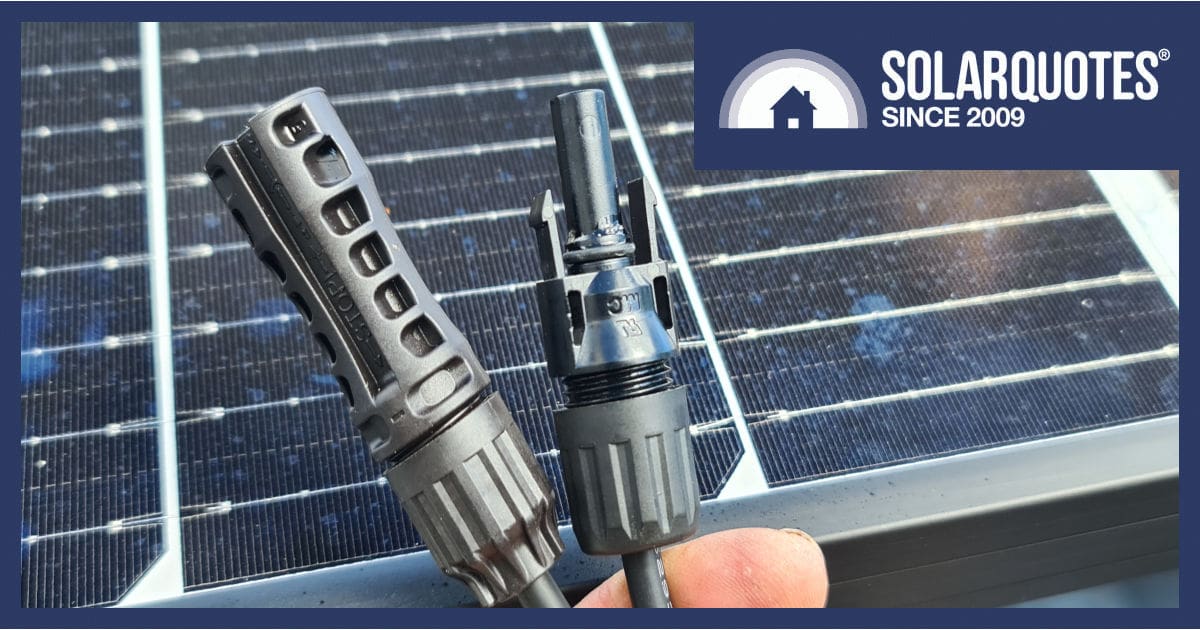
While they look different, the new model MC4 evo plug on the left is legal to mate with the old MC4 on the right.
If you’re not involved in the solar industry but wonder how millions of solar panels worldwide are connected to deliver clean energy, you might have too much spare time on your hands. Nonetheless, I’m glad you’re interested because, as I’m about to explain, this topic can be quite electrifying – particularly when an electrical fire or short circuit causes a catastrophic inverter failure.
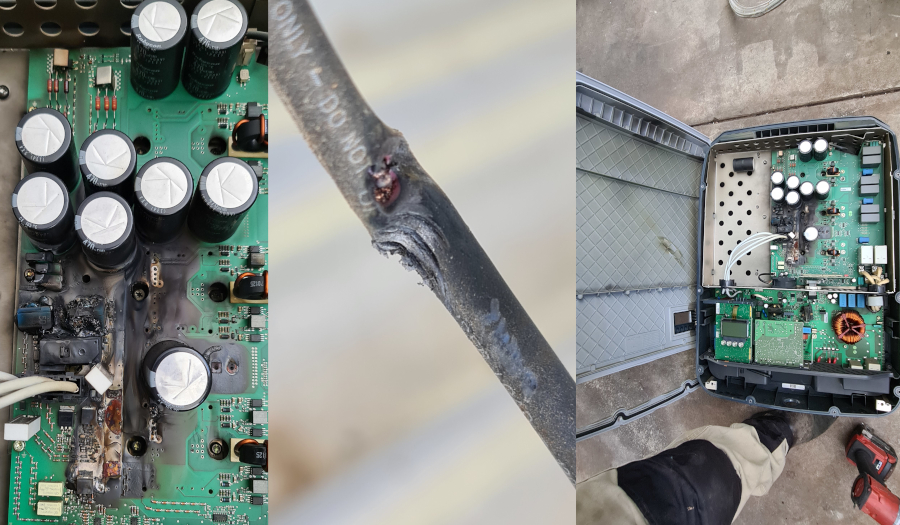
BANG. This one went off like a shotgun. When it’s up and running, the capacitors on the Fronius Eco27 are charged with maybe 800 volts DC. Once an errant tek screw pierces the cable in the middle, all that energy gleefully escapes via the short circuit to earth, and a burnt inverter is the upshot.
MC3 Connectors: Early Plug And Play
Back in the days of yore, when solar panels were a quaint 75 watts each, measuring about 500 x 1200mm, and proudly made in Australia; they were all hard-wired. Picture this; actual junction boxes with screwed connectors on the back, from which you ran flexible conduits and then threaded cables between every panel. It took hours and made laying panels flat on the roof impossible.
Before long, panels were rolling out with leads just over a metre long, allowing those 800 mm wide beauties to be linked up in a daisy chain. Array wiring took a quantum leap with the advent of MC3 connectors that simply pushed together. It was a revelation nearly as astounding as the price of MC3 tools. Two pairs of pliers for a staggering $1500!
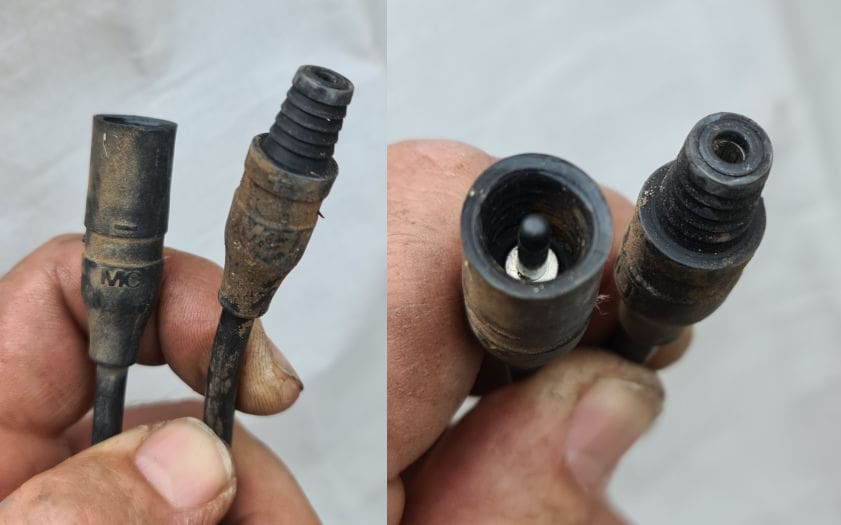
MC3. These are a sure sign that your solar panels were expensive when they were new.
While some installers would chop them off, crimp on some barrel terminals and apply heat-shrink tubing for insulation, we thought we were pretty special when we took delivery of the gear that let us properly crimp MC3 pins onto our array wiring, AND pull the rubber boots over the pins to finish them.
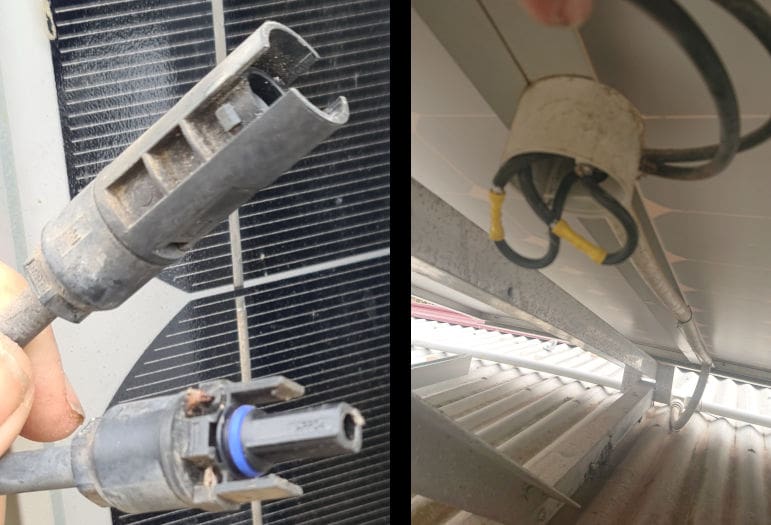
A non-compatible connector from Jaiwei PV panels with a novel junction box approach to barrel crimps on the array wiring.
This was a far cry from watching that one bloke who’d faff around soldering pins. Watching him wear down his molars, chewing on the boots to soften them, then yoinking them on with needle-nose pliers was neither industry best practice nor, in my book, particularly sane.
Then Came MC4
While other styles of plugs came and went, the market soon chose a winner: a new and improved MC3 connector called MC4. Some argue it wasn’t the best plug for the job, but everyone soon became familiar with the feel of barbed plastic pins as they clicked their way into becoming the much-imitated industry standard.

Even the kings of quality from industry membership body Solar Cutters have adopted the MC4 as a logo
In fact, the “compatible” MC4 connection became a real problem. With many different makers all trying to avoid patent infringements, the minor differences in plugs and pins meant that while they fitted together mechanically, electrically they didn’t connect properly, and most critically, they didn’t seal out moisture.
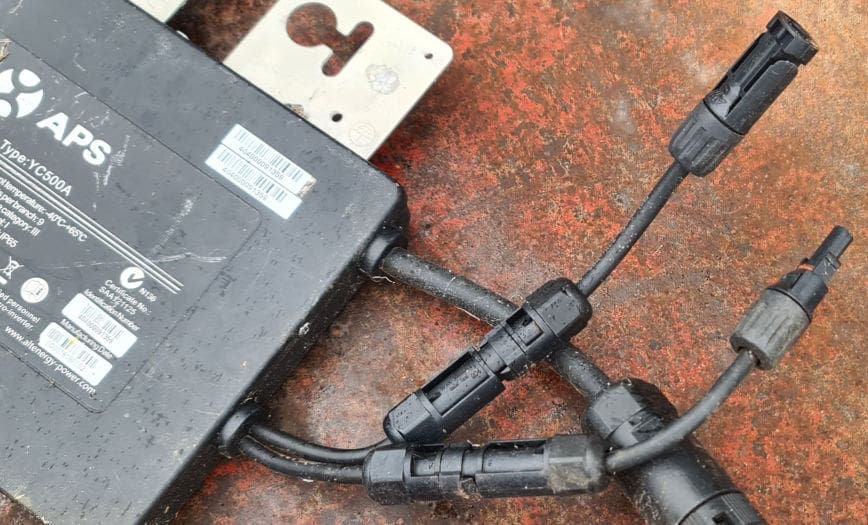
APS microinverters have one brand of plug, ET solar panels use another, so adapter leads are needed.
The result was so many burnt out connections that the next revision of the solar installation standard, AS5033, mandated that only plugs from the same maker could be mated together.
Mismatched brands were prohibited, and the style seen above with wings was banned because you don’t need a tool to open them. And you don’t want Harry homeowner opening one under load and getting blown off the roof.
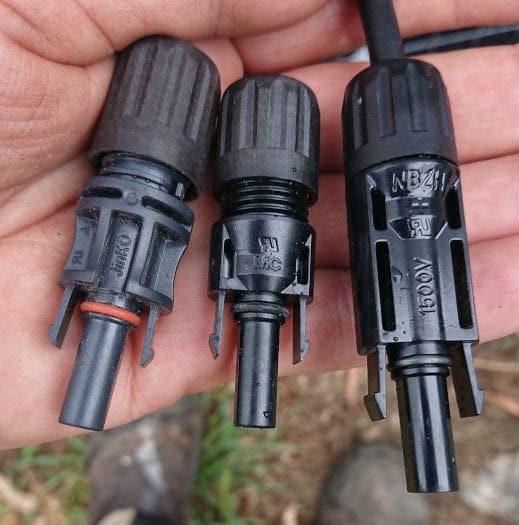
L to R, Good examples of MC4s; Jinko, Genuine Staubli MC4 and NBZH
How To Terminate MC4 Connectors Properly
I have seen MC4 plugs fitted by numpties who aren’t properly equipped with the tools or the brain power to realise they’re a danger to themselves and others. If the cable isn’t retained properly in the plug and it can be pulled out, then there’s a potential to kill someone or burn holes straight through an iron roof.
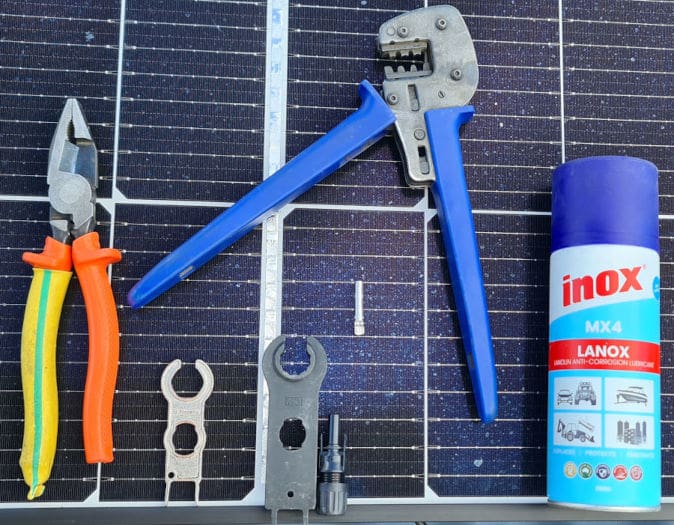
Start with your favourite pliers, spanners, MC4 crimpers and a plug to fit.
I like to use Lanox as a preservative on my own jobs. It will keep moisture at bay if the plugs are left open overnight. It stops corrosion of the metal contacts and ensures the “o” ring seal slides home easily without binding or curling up.
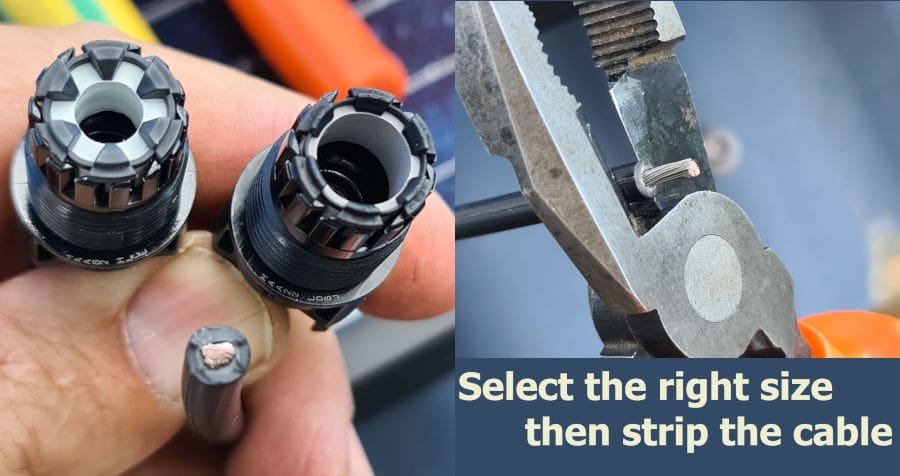
Some MC4 plugs suit larger cables. The one on the left is what the vast bulk of installs use with 4 & 6mm² cable.
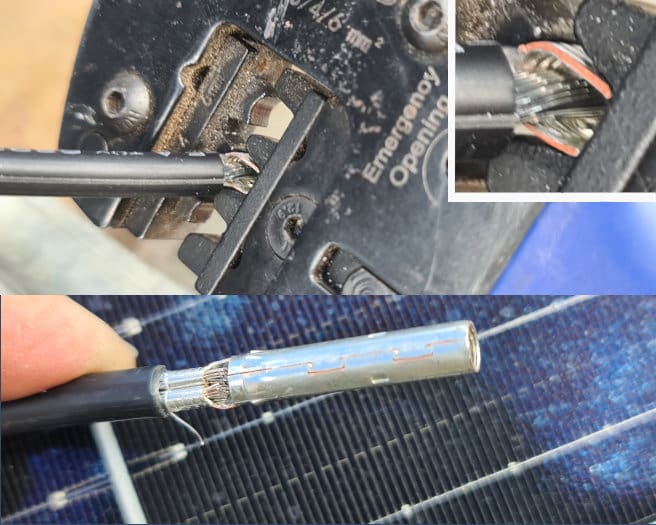
Crimping the tinned conductors and ensuring the joint is formed properly, hopefully without stray strands like this one.
Genuine MC4 spanners will slip before the gland fitting is over-tightened.
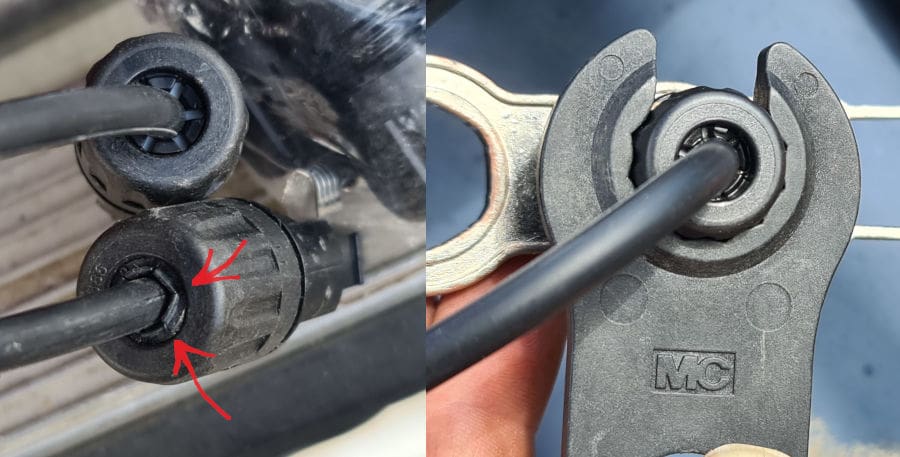
Using the right spanner prevents overtightening. Red arrows show where the gland, which suits larger cable, has been crushed onto a typical 4mm² wire.
Beware Of Crap MC4 Connectors
The very worst plug I’ve struck is this “How Full Star” piece of rubbish. It’s brand new and came out of the box broken, as you see it here. The junction box attached to an equally dubious Luxor solar panel had the same problem with cracked glands. The design is so sloppy it isn’t even compliant as being “touchproof” with a standard test finger. These crappy products are the reason we have standards.
Getting MC4 Connectors Right Really Matters
If your solar installer is not properly trained or does not take enough care to ensure these small connections are done correctly, you will soon discover that an equally small amount of moisture can bring your entire system to a halt.
When the inverter detects DC electricity from your array leaking to earth, it will switch off and, by law, send you an email to raise the alarm.
Join us in the coming weeks as I detail the calamities that lead on from badly fitted and poorly maintained solar power systems.

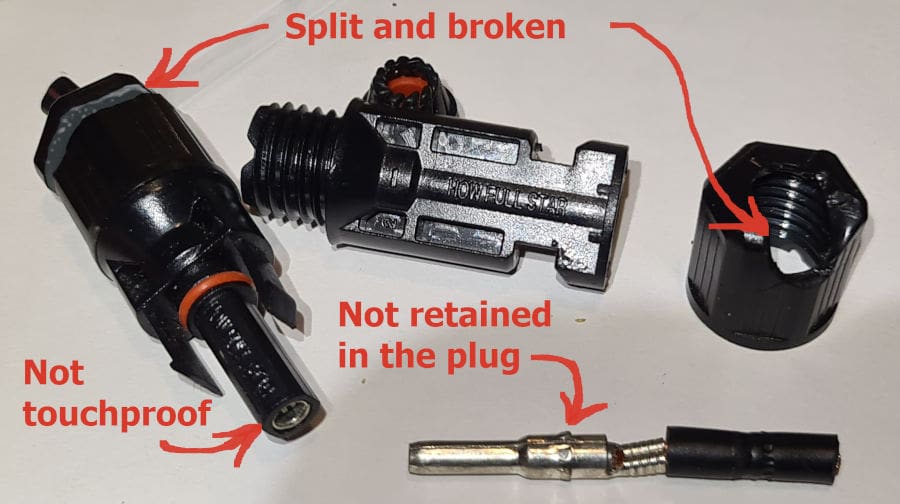
 RSS - Posts
RSS - Posts



Stripping wire using pliers or wire cutters is bad practice, and can damage the conductors. Use proper wire strippers.
In the first example of the Fronius Inveter frying due to a short circuit.
If there was a fuse or breaker in the circuit, then this shouldn’t have fried the inverter?
It seems strange that the Fronius Inverter doesn’t also have some internal protection against electrical shorts.
Hi Travis,
For memory this was a Fronius ECO 27kW. They have on board string fusing which is designed to protect parallel solar arrays from each other, but not much is capable of saving some electronics from discharging a capacitor in a few milliseconds. The inverter will normally detect earth leakage and refuse to start up, or shut down and bleed off the capacitors if there’s some slight leakage during normal operation; but if it’s up and running happily when you introduce a hard short to earth, this is the result.
Ah Ok, make’s sense, thanks
When did the MC4 connectors come into general use? Was there a “crossover phase” where installers were allowed to use up existing stocks of MC3 or was it a specific date when every installer had to change over to MC4?
Glad I could afford micro-inverters even though I have no shading. Always preferred low current gear on the roof after hearing of so many roof fires.
What is the difference between MC4 4Square and MC4 6Square? Please give a simple answer.
hi Ian.
The MC4 4Square and MC4 6Square connectors refer to the cross-sectional area of the cable they can accommodate. The “4” and “6” in their names stand for 4 square millimeters and 6 square millimeters, respectively. Roughly speaking if you need to run more than 25 metres to the array you’ll need the heavier size. 10mmsq is also available
https://midsummerwholesale.co.uk/buy/solar-cable-and-connectors/mc4-10mm